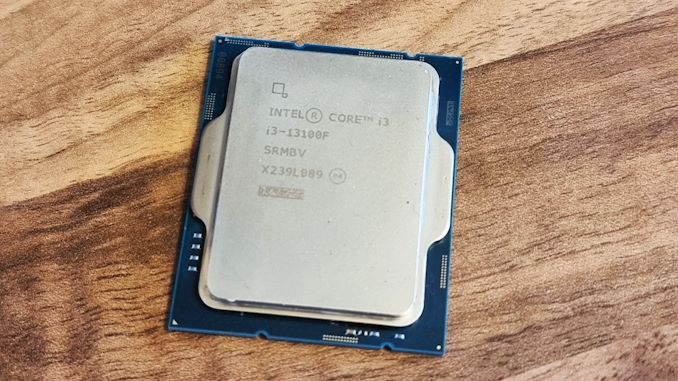
Original Link: https://www.anandtech.com/show/18740/the-intel-core-i3-13100f-review-finding-value-in-intels-cheapest-chip
The Intel Core i3-13100F Review: Finding Value in Intel's Cheapest Core Chip
by Gavin Bonshor on April 20, 2023 9:00 AM EST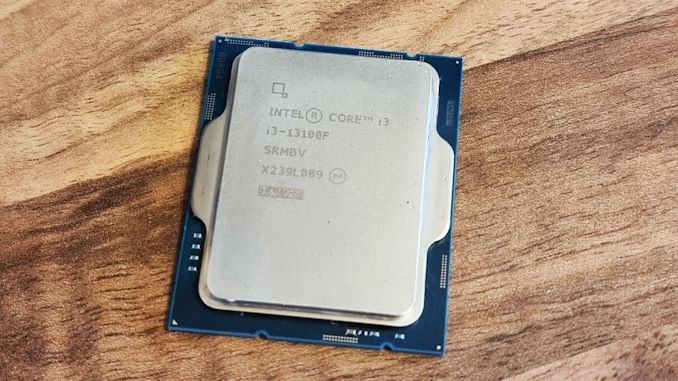
While we here at AnandTech tend to be focused at the high-end of Intel's Core CPU product stacks, the company has a far more comprehensive lineup than we typically have the time to take a look at. There are the flagship models, of course, such as the Core i9-13900K and KS SKUs, which feature the highest core counts, clockspeeds, and support for overclocking. Meanwhile for users requiring fewer cores but still want other performance, Intel also has its Core i7 and Core i5 series with many different SKUs, including some enthusiast-aimed K-series parts.
Getting away from these enthusiast parts though, Intel has a significant number of vanilla, non-K series chips. These parts typically offer a better balance of performance, power consumption, and efficiency at every level. This is also where you'll find Intel's cheapest parts– which don't have enthusiast variations – the Core i3 series. Aimed at the entry-level market, the i3 parts are built around four Performance (P) cores, dropping the efficiency cores in exchange for offering entry-level users a cheaper alternative for non-critical and less demanding tasks.
For this generation Intel technically only offers a single i3 tier, the i3-13100, which is further broken up into three configurations: the base version, the 35W TDP version (i3-13100T), and finally a version without working integrated graphics, the i3-13100F. Today we're taking a look at the latter of those chips, which at an MSRP of $109 is the single cheapest chip in the 13th generation Core lineup, making it the true entry-level part for this generation.
From a hardware perspective, the Core i3-13100F offers 4 P cores with a maximum turbo frequency of 4.5GHz, which are backed by 12 MB of L3 cache. As previously noted, the only feature difference for this part is that the Core i3-13100F doesn't include the integrated graphics (Intel UHD Graphics 730) normally found on the i3-13100, and as a result it's intended for use with discrete graphics.
As the cheapest of Intel's 13th generation Core series SKUs, is there any real value to be found? And does the i3-13100F deliver enough performance to justify it to users on a budget? Today we're digging in to see if the Core i3-13100F does enough to claim the quad-core top crown, and determine how it compares to the rest of Intel and AMD's entry to mid-range offerings.
Before we dive right into the Core i3-13100F review, below is a list of our detailed Intel 13th gen Core/Raptor Lake coverage:
- Intel Core i9-13900K and i5-13600K Review: Raptor Lake Brings More Bite
- The Intel Core i9-13900KS Review: Taking Intel's Raptor Lake to 6 GHz
- Intel Announces Non-K 13th Gen Core For Desktop: New 65 W and 35 W Processors
- A Lighter Touch: Exploring CPU Power Scaling on Core i9-13900K and Ryzen 9 7950X
Intel Core i3-13100F: Comparing Apples to Apples, Alder Lake Refresh?
Intel and AMD have options to cater to the entry-level market with their Core i3 and Ryzen 3/5 series. While we've seen a number of these high-end and flagship SKUs from both parties over the last couple of months, and the entry-level range is perhaps where the highest levels of value can be had, especially for users and gamers on a tight budget.
There is, of course, a significant gap in performance going from an i3 with four P cores to a 24-core (8P+16E) Core i9 processor in terms of raw compute performance, and the higher Core i9/i7 series will undoubtedly munch through tasks such as video rendering and encoding faster. For any workload or task that can utilize more than four cores, it's likely more advantageous for enthusiasts and professionals to opt for the Core i9/i7 series, but, of course, not every user needs that much power.
The Intel Core i3-13100F is an interesting proposition for those types of users that don't envisage doing hefty workloads, but require a functional system that still delivers solid performance at a lower overall cost than Intel's higher-end chips. It's based around four performance cores based on Intel's Golden Cove microarchitecture, which is the same core as Intel's 12th Gen core series performance cores.
| Intel Core i3 Specifications | ||||||||
| AnandTech | Cores P+E/T |
P-Core Base |
P-Core Turbo |
L3 Cache (MB) |
iGPU | Base W |
Turbo W |
MSRP ($) |
| i3-13100 | 4+0/8 | 3400 | 4500 | 12 | 730 | 60 | 89 | $134 |
| i3-13100F | 4+0/8 | 3400 | 4500 | 12 | - | 58 | 89 | $109 |
| i3-13100T | 4+0/8 | 2500 | 4200 | 12 | 730 | 58 | 69 | $134 |
| i3-12300 | 4+0/8 | 3500 | 4400 | 12 | 730 | 60 | 89 | $143 |
| i3-12300T | 4+0/8 | 2300 | 4200 | 12 | 730 | 35 | 69 | $143 |
| i3-12100 | 4+0/8 | 3300 | 4300 | 12 | 730 | 60 | 89 | $122 |
| i3-12100F | 4+0/8 | 3300 | 4300 | 12 | - | 58 | 89 | $97 |
| i3-12100T | 4+0/8 | 2200 | 4100 | 12 | 730 | 35 | 89 | $122 |
The performance cores of the Core i3-13100F feature a base clock of 3.4 GHz, with an all-core turbo of 4.5 GHz. When compared directly to the Core i3-12300, we reviewed last year; the Core i3-13100/13100F has the same cores, the same 12 MB of Intel Smart L3 cache, and the same turbo power rating of 89 W. The most significant difference between the top Intel 12th Gen Core i3 and the latest 13th Gen Core i3 is a 100 MHz variation in core frequency; -100 MHz on the base clock but a 100 MHz increase in the turbo clock speeds. All of Intel's 13th and 12th Gen Core i3 series chips can support either DDR5-4800 or DDR4-3200 memory, which adds some flexibility in terms of platform support available, particularly for users on a budget.
Given both the Core i3-13100F and the Core i3-12300 both have the same Golden Cove cores, very similar core clock speeds, and similar TDPs, it would be fair to think that the 13th Gen Core i3 series is basically a 12th Gen refresh here, and it's hard to argue that point. But underpinning hardware aside, this also reflects how Intel has compressed its i3 product stack for this generation of chips. Intel's previous 12th Gen Core i3 series had two variations – a (12)300 and (12)100 SKU – whereas Intel has rolled it down into just one primary SKU line for the 13th Gen Core i3: the 13100 series. This means that the i3 family really only offers a single performance level to pick from for this generation, though there are 3 variants in total. These are the baseline Core i3-13100, the Core i3-13100T for lower-powered computing, and the ultra-budget Core i3-13100F without integrated graphics, which we're reviewing today.
While we don't expect there to be any performance differences between the Core i3-13100F and the Core i3-13100 – they have the same cores, same clock speeds, the same everything bar the iGPU– the Core i3-13100F presents a straightforward improvement in Intel's CPU stack, especially at its current street price of $100. The Core i3-13100F all but replaces the $97 Core i3-12100F, offering 200 MHz more turbo headroom for what's essentially the same street price. Otherwise Intel's official MSRPs at least try to place the i3-13100F as a higher tier chip, but especially with the softening market for consumer tech spending, the i3-13100F has little choice but to fill in at $100 if it wants to more quickly move.
In any case, as with Intel's 12th Gen Core i3 processors, the retail versions of the 13th Gen Core i3 series CPUs also come with Intel's Laminar RM1 stock cooler. This reduces the overall system cost as an aftermarket cooler isn't required, but it's also a good move as an 89 W CPU doesn't need an AIO or a full-tower cooler such as the Noctua NH-D15. Sure, the Intel Laminar RM1 cooler doesn't feature flashy LEDs or RGB. Still, the crux is that the Core i3 series is designed as a mainstream offering to deliver proportionate levels of compute performance for an entry-level price.
The Entry-Level Segment: Core i3-13100F versus AMD Ryzen 3 5300G
Sizing up the competition, what's notable here is Intel's entry-level 13th Gen Core i3 parts end up being in a much cheaper product segment than what's available under AMD's flagship Ryzen 7000 lineup. AMD's hasn't released any Ryzen 3-grade quad-core offerings for their latest Ryzen 7000 series, so Intel isn't even going up against a current-generation AMD chip as their direct competitor.
instead, the most recently launched AMD Ryzen processor with four cores is the Ryzen 3 5300G processor, which was actually OEM only when it launched back in 2021. The Zen 3-based processor is currently available at retailers such as Amazon for $100 as well, making it the anchor of AMD's budget processor lineup and the direct competitor to the i3-13100F.
The good news for Intel here is that this means the 13th Gen i3 processors are going up against older Zen 3 designs, and not AMD's improved Zen 4 hardware – so this is basically the Alder Lake versus Zen 3 quad core fight all over again, a fight Intel won last time. The not-as-good news for Intel is that it means that AMD is offering a decent integrated GPU on their $100 chip when Intel is not, a potentially significant advantage on a budget system.
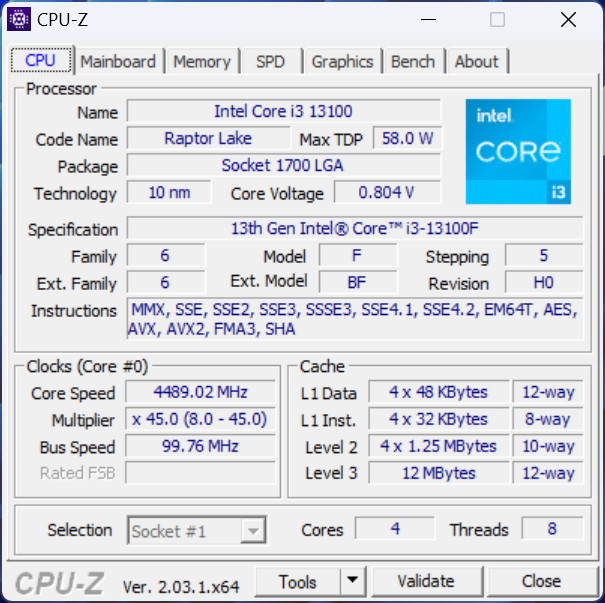
Intel Core i3-13100F CPU-Z screenshot
Otherwise, the next step up in AMD's stack is the Ryzen 5 5500G ($138), the six core version of the same die used in the 5300G. Two additional CPU cores are a significant gain among these budget processors, though the extra $38 is also a similarly big leap in pricing, relatively speaking.
Past that is AMD's cheapest Zen 4 processor, the Ryzen 5 7600 ($229). At over twice the price of the i3-13100F, there's a clear gulf between the parts in price and expected performance. Still, with six Zen 4 CPU cores turboing up to 5.1GHz, it's a chip that warrants a seat at the table, if only for the potential spoiler effect.
The Core i3-13100F is an interesting proposition for users and gamers on a budget. The Core i3-13100F and the rest of the 13th Gen Core series processors are supported by more affordable motherboards and a much lower price than the AMD Ryzen 7000 offerings. For this review and to create a level playing field, we've tested the Core i3-13100F (as well as all of Intel's 13th Gen CPUs) with DDR5-4800 memory as per the chip's JEDEC specification.
The Current CPU Test Suite
For our Intel Core i3-13100F testing, we are using the following test system:
| Intel 13th Gen Core System (DDR5) | |
| CPU | Core i3-13100F ($109) 4 Cores, 8 Threads 58 W Base TDP 89 W Turbo TDP |
| Motherboard | MSI MPG Z790 Carbon WIFI |
| Memory | SK Hynix 2x32 GB DDR5-4800 CL40 |
| Cooling | EKWB EK-AIO Elite 360 D-RGB 360mm |
| Storage | SK Hynix Platinum P41 2TB PCIe 4.0 x4 |
| Power Supply | Corsair HX1000 |
| GPUs | AMD Radeon RX 6950 XT, 31.0.12019 |
| Operating Systems | Windows 11 22H2 |
Our updated CPU suite for 2023 includes various benchmarks, tests, and workloads designed to show variance in performance between different processors and architectures. These include UL's latest Procyon suite with both office and photo editing workloads simulated to measure performance in these tasks, CineBench R23, Dwarf Fortress, Blender 3.3, and C-Ray 1.1.
Meanwhile, we've also carried over some older (but still relevant/enlightening) benchmarks from our CPU 2021 suite. This includes benchmarks such as Dwarf Fortress, Factorio, and Dr. Ian Cutress's 3DPMv2 benchmark.
We have also updated our pool of games going forward into 2023 and beyond, including the latest F1 2022 racing game, the CPU-intensive RTS Total War: Warhammer 3, and the popular Hitman 3.
CPU Benchmark Performance: Power And Office
Our previous sets of ‘office’ benchmarks have often been a mix of science and synthetics, so this time we wanted to keep our office section purely on real-world performance. We've also incorporated our power testing into this section too.
The biggest update to our Office-focused tests for 2023 and beyond include UL's Procyon software, which is the successor to PCMark. Procyon benchmarks office performance using Microsoft Office applications, as well as Adobe's Photoshop/Lightroom photo editing software, and Adobe Premier Pro's video editing capabilities. Due to issues with UL Procyon and the video editing test, we haven't been able to properly run these, but once we identify a fix with UL, we will re-test each chip.
We are using DDR5-4800 memory on the Intel Core i3-13100F as per the JEDEC specifications. Other recent chips, such as Intel's 13th/12th Gen Core series and Ryzen 7000 processors, are also tested at the rated JEDEC specifications. We tested the aforementioned platforms with the following settings:
- DDR5-5600B CL46 - Intel 13th Gen
- DDR5-5200 CL44 - Ryzen 7000
- DDR5-4800 (B) CL40 - Intel 12th Gen
- DDR5-4800 (B) CL40 - Intel 13th Gen Core i3 series
All other CPUs such as Ryzen 5000 and 3000 were tested at the relevant JEDEC settings as per the processor's individual memory support with DDR4.
Power
The nature of reporting processor power consumption has become, in part, a bit of a nightmare. Historically the peak power consumption of a processor, as purchased, is given by its Thermal Design Power (TDP, or PL1). For many markets, such as embedded processors, that value of TDP still signifies the peak power consumption. For the processors we test at AnandTech, either desktop, notebook, or enterprise, this is not always the case.
Modern high-performance processors implement a feature called Turbo. This allows, usually for a limited time, a processor to go beyond its rated frequency. Exactly how far the processor goes depends on a few factors, such as the Turbo Power Limit (PL2), whether the peak frequency is hard coded, the thermals, and the power delivery. Turbo can sometimes be very aggressive, allowing power values 2.5x above the rated TDP.
AMD and Intel have different definitions for TDP that are, broadly speaking, applied the same. The difference comes from turbo modes, turbo limits, turbo budgets, and how the processors manage that power balance. These topics are 10000-12000 word articles in their own right, and we’ve got a few articles worth reading on the topic.
- Why Intel Processors Draw More Power Than Expected: TDP and Turbo Explained
- Talking TDP, Turbo and Overclocking: An Interview with Intel Fellow Guy Therien
- Reaching for Turbo: Aligning Perception with AMD’s Frequency Metrics
- Intel’s TDP Shenanigans Hurts Everyone
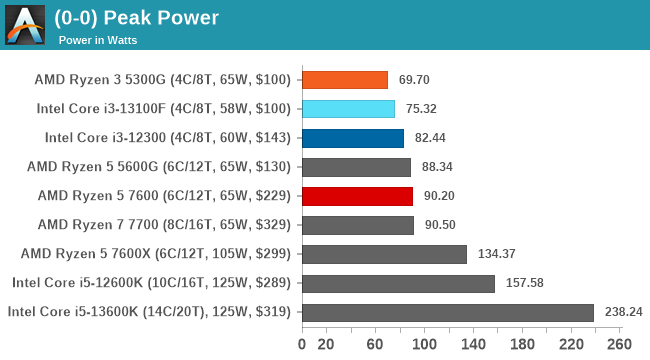
Looking at the peak power values for all of the sub $350 CPUs we've tested with the latest CPU suite, the Core i3-13100F, as expected draws the least power overall. The difference between the Core i3-13100F and the Core i3-12300 is around 7 W, which isn't massive, especially given they have the same Intel Golden Cove performance cores.
Diving into the power consumption of the Core i3-13100F during a Prime95 sustained load, we found that power was delivered consistently between 72 and 75 W, with no drop in frequency and power unless the compute load itself dropped off. This means that peak power is delivered for the duration when at full load. It also shows that Intel's Core i3-13100F is performing well within the associated turbo TDP power limit of 89 W.
Office/Web
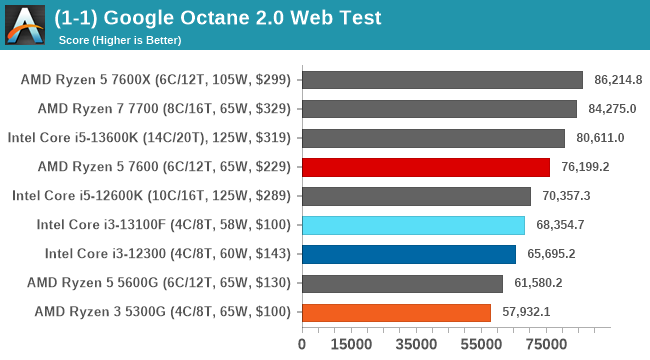
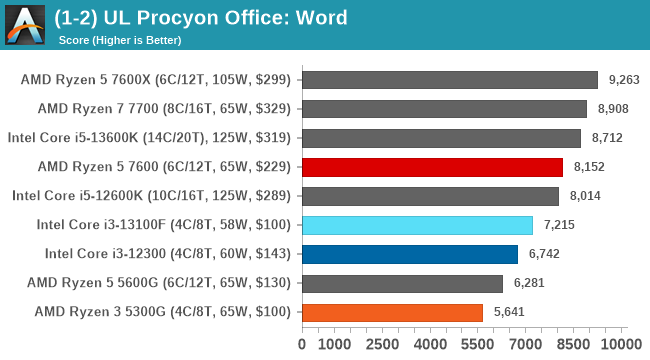
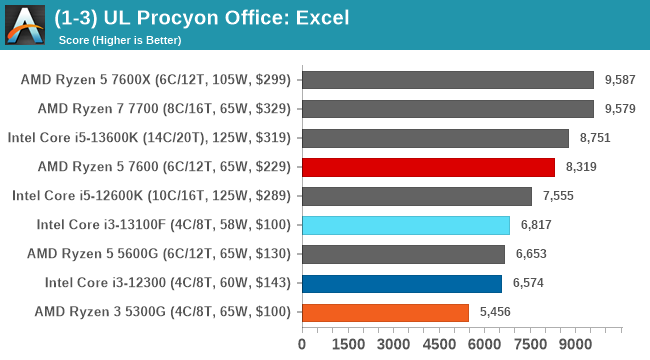

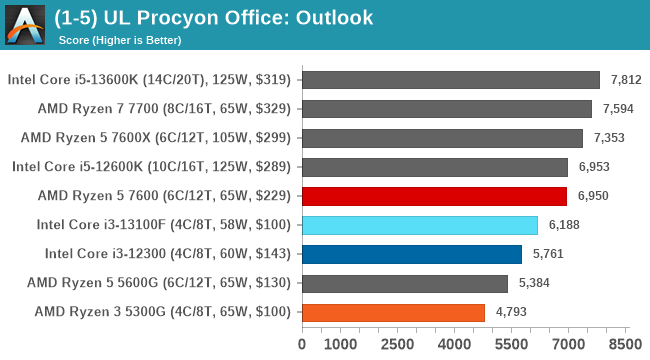
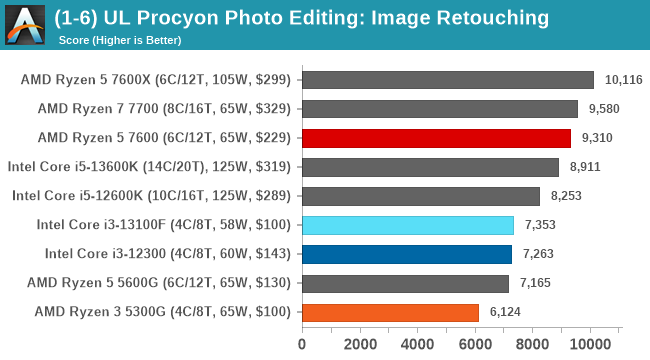
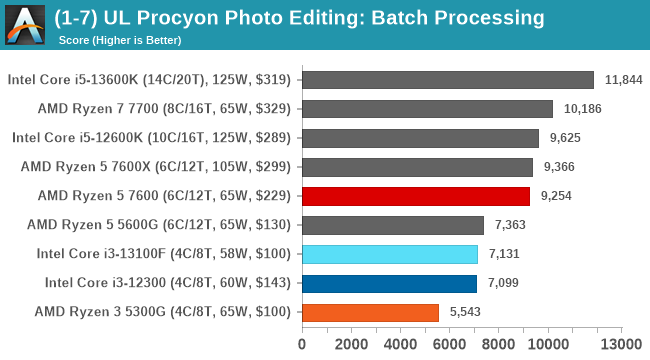

In office and productivity based benchmarks, the Core i3-13100F does very well considering it's a quad-core chip pitted up against six, eight, and even the Core i5-13600K, which is a 14C/20T part. As expected, the Core i3-13100F is slightly better than the Core i3-12300 as it has slightly faster cores.
Comparing Intel's latest quad-core to AMD's most recent quad-core, Intel has a distinct advantage in IPC performance as it's a newer process (Raptor/Alder Lake versus Zen 3) and clock speeds.
CPU Benchmark Performance: Science
Our Science section covers all the tests that typically resemble more scientific-based workloads and instruction sets. For our 2023 CPU suite, we've also added SciMark 2.0 which measures numerical kernels and various computational routines found in numeric coding.
We are using DDR5-4800 memory on the Intel Core i3-13100F as per the JEDEC specifications. Other recent chips, such as Intel's 13th/12th Gen Core series and Ryzen 7000 processors, are also tested at the rated JEDEC specifications. We tested the aforementioned platforms with the following settings:
- DDR5-5600B CL46 - Intel 13th Gen
- DDR5-5200 CL44 - Ryzen 7000
- DDR5-4800 (B) CL40 - Intel 12th Gen
- DDR5-4800 (B) CL40 - Intel 13th Gen Core i3 series
All other CPUs such as Ryzen 5000 and 3000 were tested at the relevant JEDEC settings as per the processor's individual memory support with DDR4.
Science



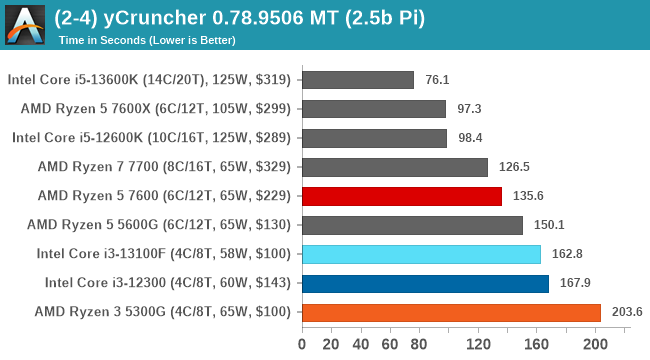
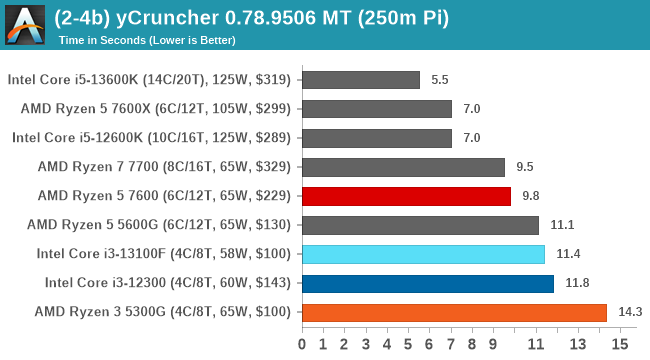
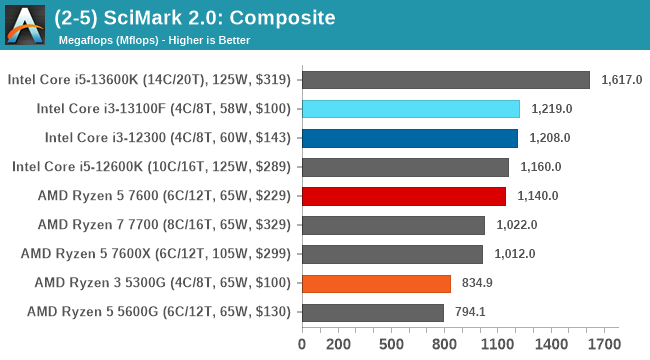


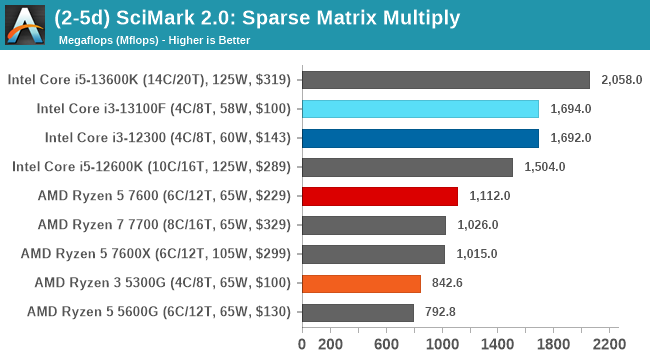
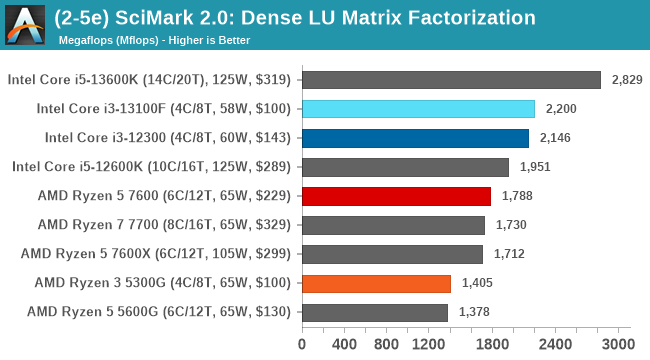
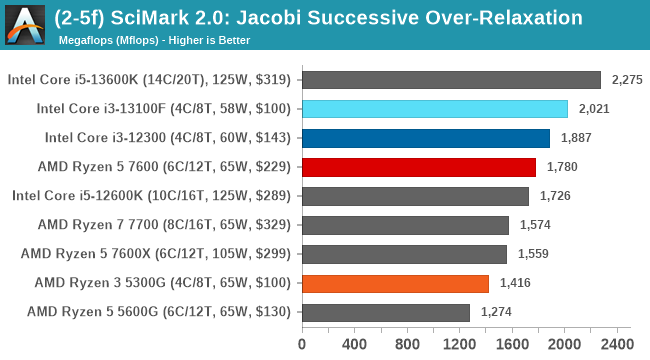

AMD's support for AVX-512 instruction sets with its Ryzen 7000 processors and Intel's decision to omit this in its desktop processors for its 12th and 13th Gen Core series chips means that the Ryzen 5 7600, already overpowered in this fight, excels even in this area in comparison to the Core i3-13100F.
Otherwise, as expected, both the Core i3-13100F and the previous Core i3-12300 perform similarly to each other. This also means the Ryzen 5300G gets left behind in most testing; there's only so far AMD can get on more limited clockspeeds and cache.
CPU Benchmark Performance: Simulation
Simulation and Science have a lot of overlap in the benchmarking world. The benchmarks that fall under Science have a distinct use for the data they output – in our Simulation section, these act more like synthetics but at some level are still trying to simulate a given environment.
In the encrypt/decrypt scenario, how data is transferred and by what mechanism is pertinent to on-the-fly encryption of sensitive data - a process by which more modern devices are leaning to for software security.
We are using DDR5-4800 memory on the Intel Core i3-13100F as per the JEDEC specifications. Other recent chips, such as Intel's 13th/12th Gen Core series and Ryzen 7000 processors, are also tested at the rated JEDEC specifications. We tested the aforementioned platforms with the following settings:
- DDR5-5600B CL46 - Intel 13th Gen
- DDR5-5200 CL44 - Ryzen 7000
- DDR5-4800 (B) CL40 - Intel 12th Gen
- DDR5-4800 (B) CL40 - Intel 13th Gen Core i3 series
All other CPUs such as Ryzen 5000 and 3000 were tested at the relevant JEDEC settings as per the processor's individual memory support with DDR4.
Simulation


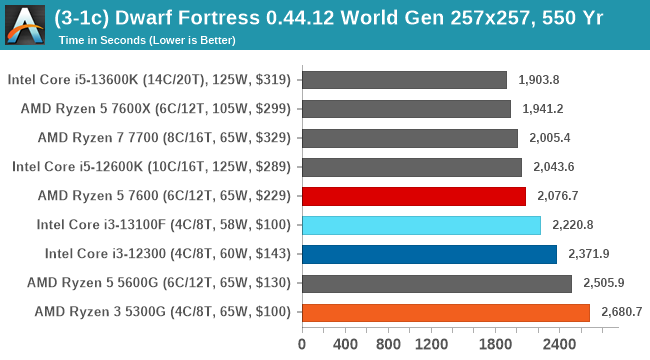
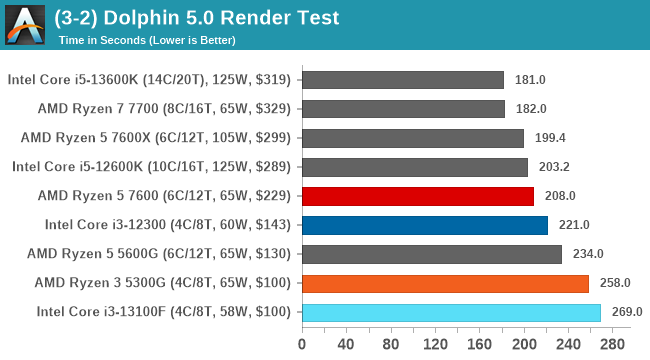
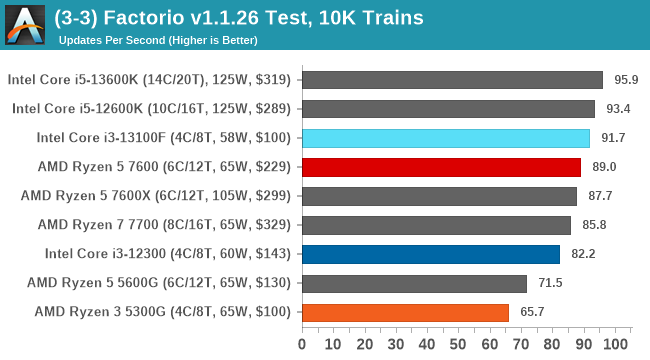

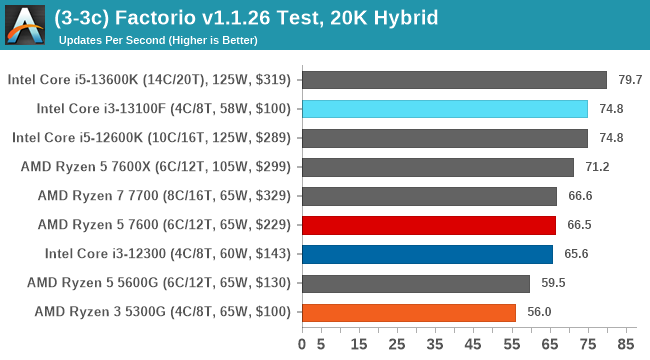
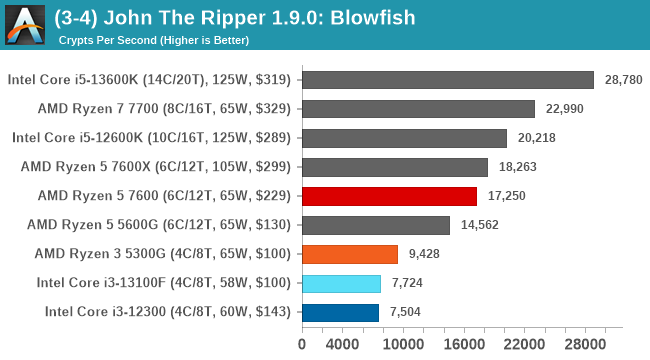

In our simulation-based tests, the Core i3-13100F lacks the grunt of the other chips simply because it only has four cores. The Core i3-13100F did, however, perform much better than expected in some of our Dwarf Fortress and Factorio benchmarks. It should be noted that it's apparent that in simulations, chips with a higher core count, higher IPC performance, and faster turbo clock speeds typically benefit users better that are doing compute heavy workloads.
CPU Benchmark Performance: Rendering And Encoding
Rendering tests, compared to others, are often a little more simple to digest and automate. All the tests put out some sort of score or time, usually in an obtainable way that makes it fairly easy to extract. These tests are some of the most strenuous in our list, due to the highly threaded nature of rendering and ray-tracing, and can draw a lot of power.
If a system is not properly configured to deal with the thermal requirements of the processor, the rendering benchmarks are where it would show most easily as the frequency drops over a sustained period of time. Most benchmarks in this case are re-run several times, and the key to this is having an appropriate idle/wait time between benchmarks to allow for temperatures to normalize from the last test.
One of the interesting elements of modern processors is encoding performance. This covers two main areas: encryption/decryption for secure data transfer, and video transcoding from one video format to another.
In the encrypt/decrypt scenario, how data is transferred and by what mechanism is pertinent to on-the-fly encryption of sensitive data - a process by which more modern devices are leaning to for software security.
We are using DDR5-4800 memory on the Intel Core i3-13100F as per the JEDEC specifications. Other recent chips, such as Intel's 13th/12th Gen Core series and Ryzen 7000 processors, are also tested at the rated JEDEC specifications. We tested the aforementioned platforms with the following settings:
- DDR5-5600B CL46 - Intel 13th Gen
- DDR5-5200 CL44 - Ryzen 7000
- DDR5-4800 (B) CL40 - Intel 12th Gen
- DDR5-4800 (B) CL40 - Intel 13th Gen Core i3 series
All other CPUs such as Ryzen 5000 and 3000 were tested at the relevant JEDEC settings as per the processor's individual memory support with DDR4.
Rendering
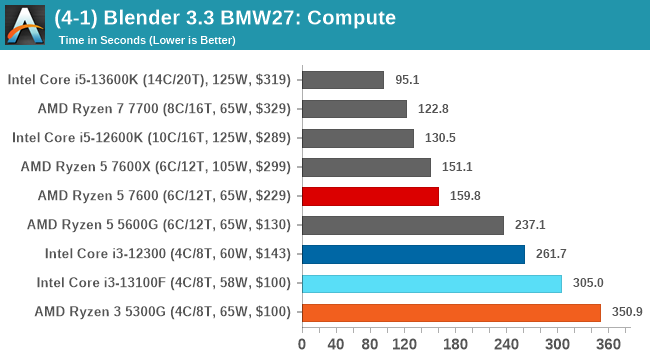
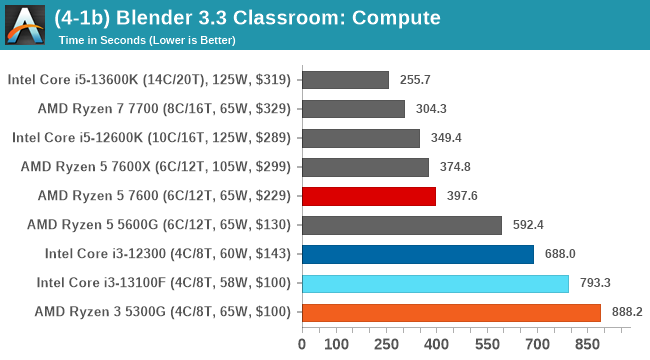
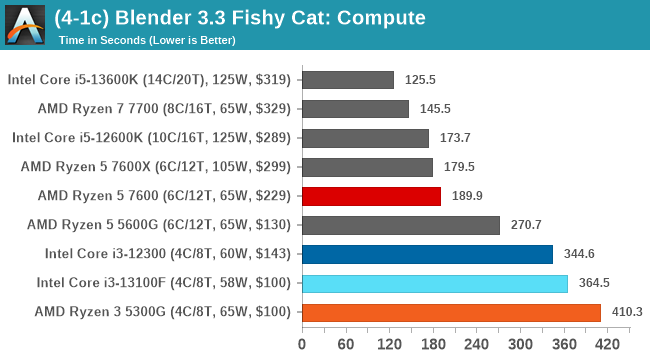
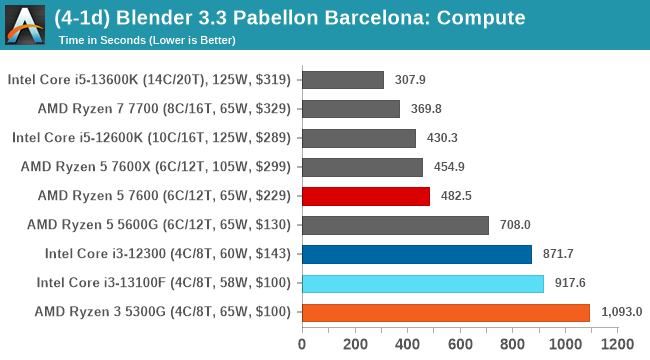
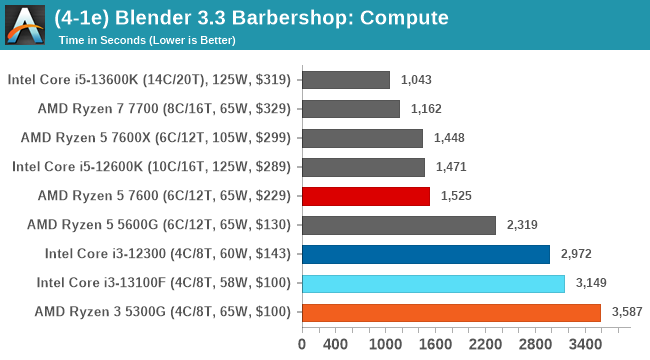

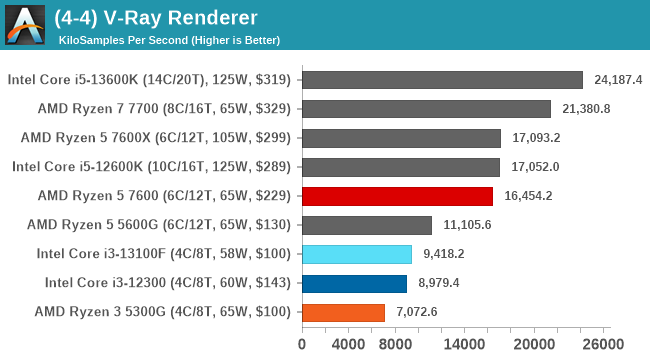

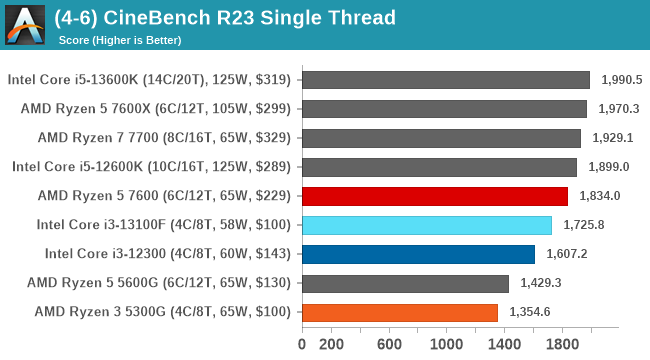

Among our quad core chips, the i3-13100F is unsurprisingly in good standing, though it does fall behind the i3-12300 more often than would expect. Otherwise, in these tests cores and frequency are (almost) everything, illustrating the performance limitations of a quad core CPU in an age where consumer chips ship with upwards of 24 of the things.
Encoding
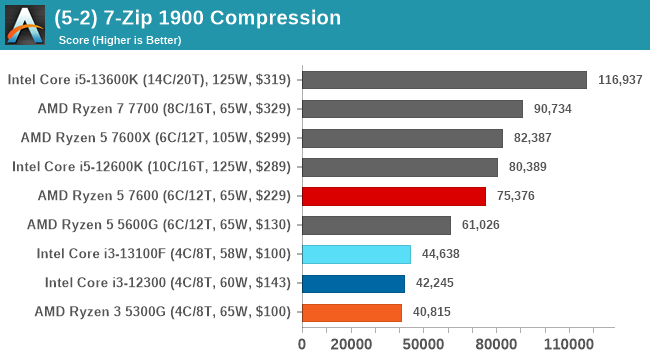
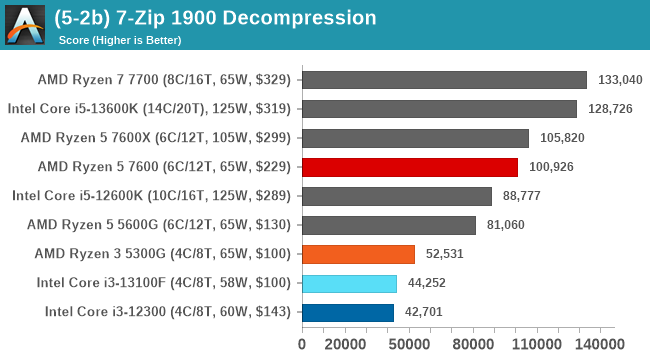
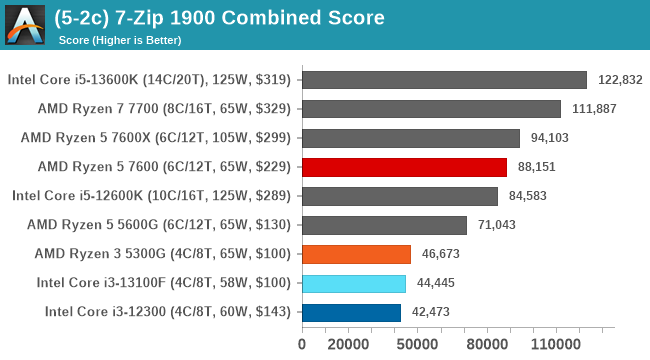

Looking at encoding performance, we see a similar trend as we did with our simulation and rendering benchmarks; having just four cores puts a cap on absolute performance versus more expensive chips with additional CPU cores. It's clear that having four cores shows limitations in compute tasks, but with performance very closely matched with the Core i3-12300, the Core i3-13100F does a good job all things considered.
CPU Benchmark Performance: Legacy Tests
In order to gather data to compare with older benchmarks, we are still keeping a number of tests under our ‘legacy’ section. This includes all the former major versions of CineBench (R15, R11.5, R10) as well as Geekbench 4 and 5. We won’t be transferring the data over from the old testing into Bench, otherwise, it would be populated with 200 CPUs with only one data point, so it will fill up as we test more CPUs like the others.
We are using DDR5-4800 memory on the Intel Core i3-13100F as per the JEDEC specifications. Other recent chips, such as Intel's 13th/12th Gen Core series and Ryzen 7000 processors, are also tested at the rated JEDEC specifications. We tested the aforementioned platforms with the following settings:
- DDR5-5600B CL46 - Intel 13th Gen
- DDR5-5200 CL44 - Ryzen 7000
- DDR5-4800 (B) CL40 - Intel 12th Gen
- DDR5-4800 (B) CL40 - Intel 13th Gen Core i3 series
All other CPUs such as Ryzen 5000 and 3000 were tested at the relevant JEDEC settings as per the processor's individual memory support with DDR4.
Legacy
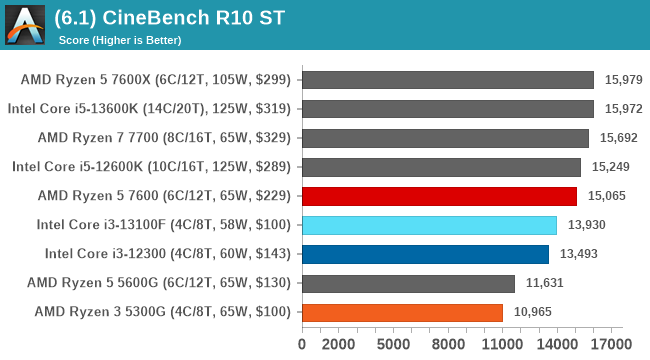
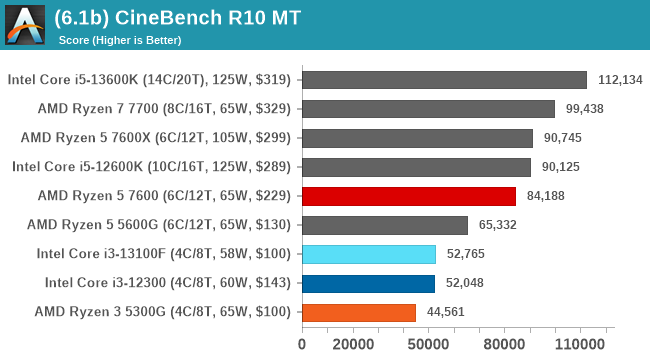
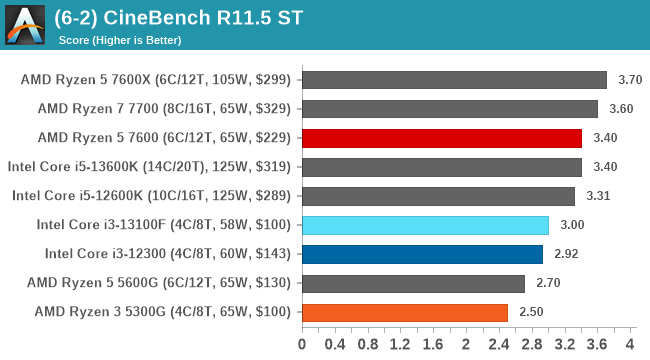
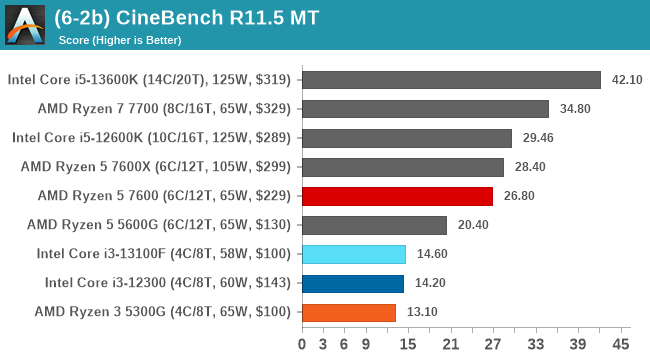
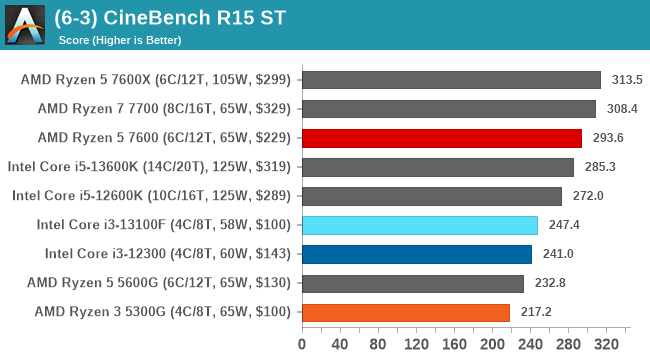
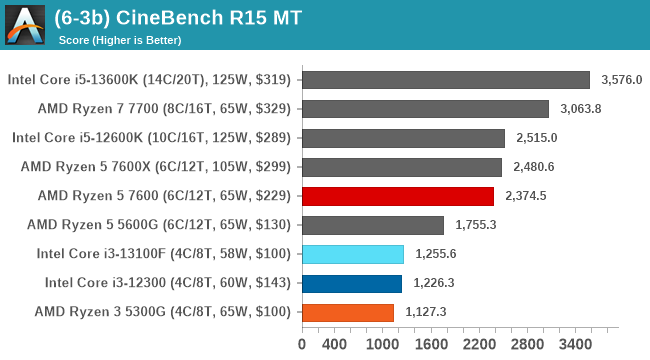
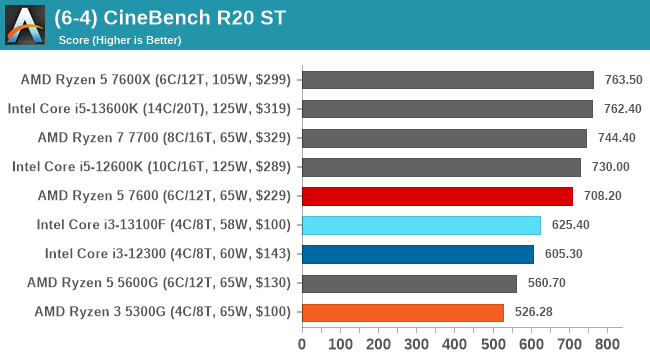
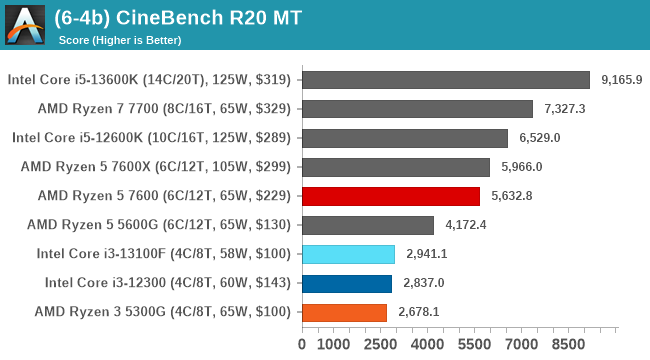
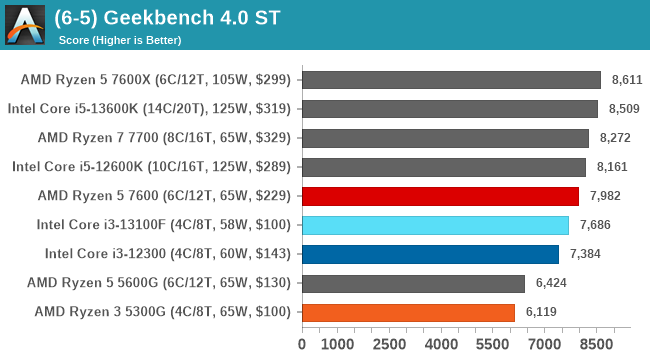
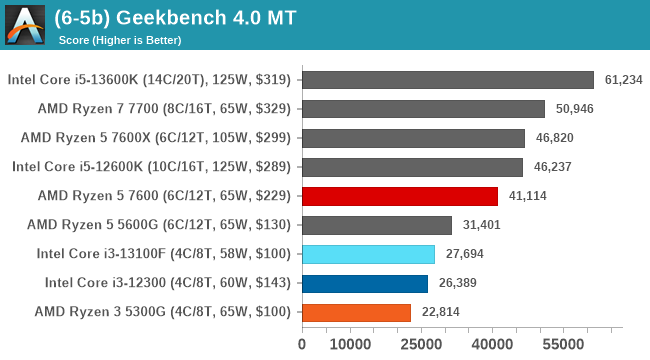
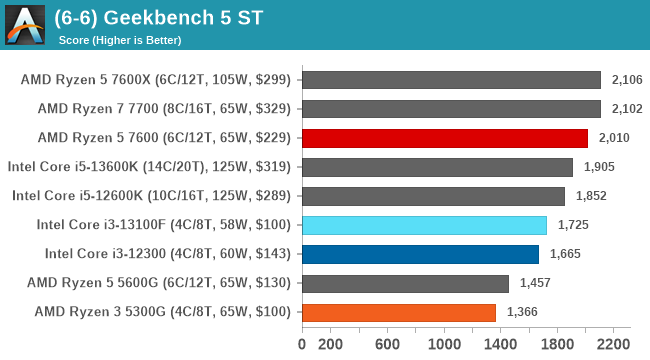
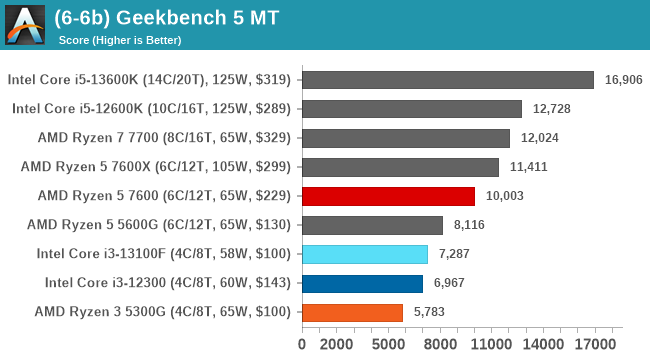
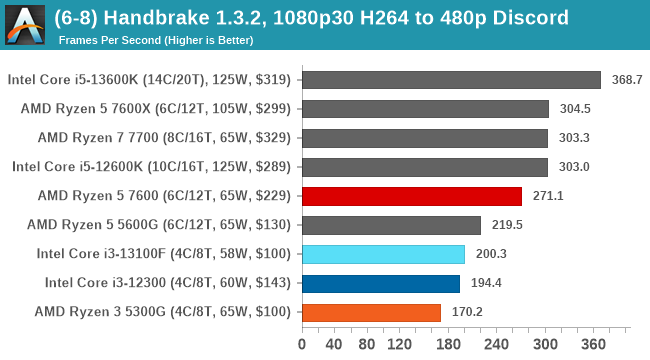

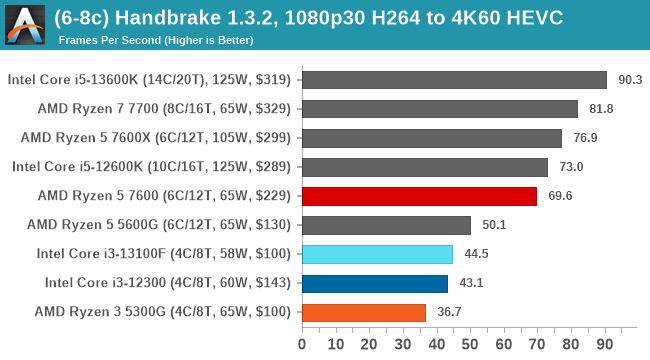
Our legacy tests are exactly what they represent, a combination of older and outdated workloads, but they still provide some insight into performance benefits. As we've seen throughout our computational workloads, having four cores does limit performance somewhat. Still, the Core i3-13100F is the fastest quad-core we've tested with the new suite, albeit only marginally sitting above the previous generation's Core i3-12300.
Gaming Performance: 720p And Lower
The reason we test games in CPU reviews at lower resolutions such as 720p and below is simple; titles are more likely to be CPU bound than they are GPU bound at lower resolutions. This means there are more frames for the processor to process as opposed to the graphics card doing the majority of the heavy lifting.
There are some variances where some games will still use graphical power, but not as much CPU grunt at these smaller resolutions, and this is where we can show where CPU limitations lie in terms of gaming.
Normally, of course, this would be the domain of integrated GPUs. However since the Core i3-13100F is a true ultra-budget entry-level processor – sans even the most basic of integrated graphics – there's nothing to speak of here. You'll need a discrete video card to see anything on a 13100F system, so we'll start things off with a look at gaming with a discrete GPU – making this a pure CPU test in the end.
We are using DDR5-4800 memory on the Intel Core i3-13100F as per the JEDEC specifications. Other recent chips, such as Intel's 13th/12th Gen Core series and Ryzen 7000 processors, are also tested at the rated JEDEC specifications. We tested the aforementioned platforms with the following settings:
- DDR5-5600B CL46 - Intel 13th Gen
- DDR5-5200 CL44 - Ryzen 7000
- DDR5-4800 (B) CL40 - Intel 12th Gen
- DDR5-4800 (B) CL40 - Intel 13th Gen Core i3 series
All other CPUs such as Ryzen 5000 and 3000 were tested at the relevant JEDEC settings as per the processor's individual memory support with DDR4.
Civilization VI
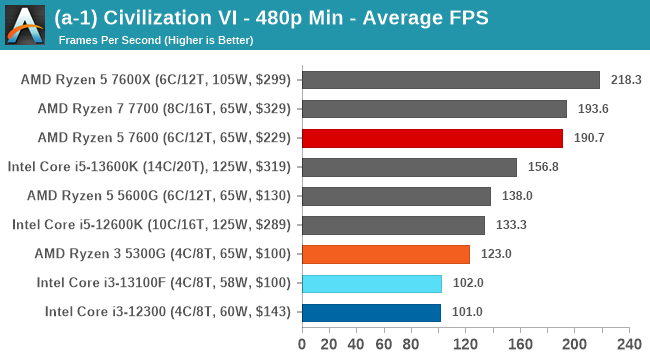
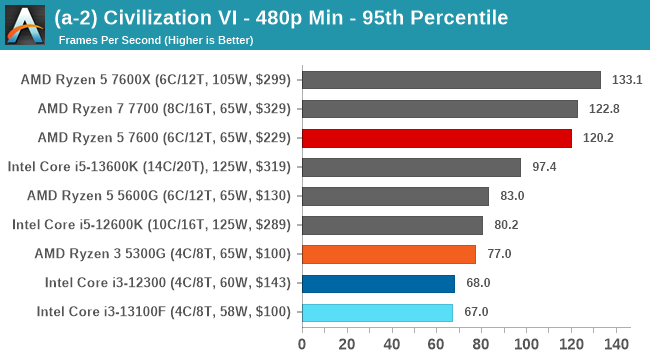
World of Tanks

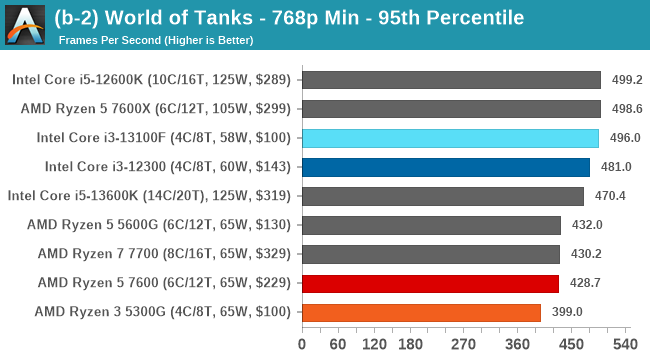
Borderlands 3
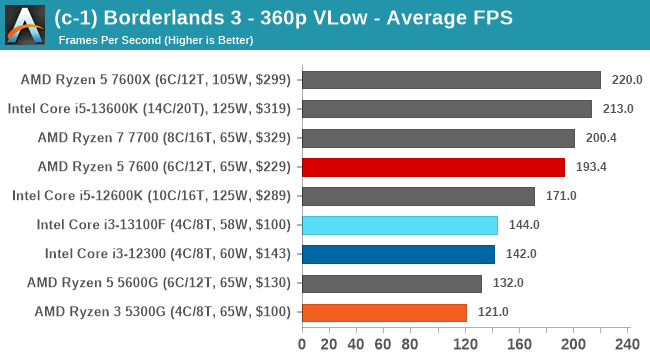
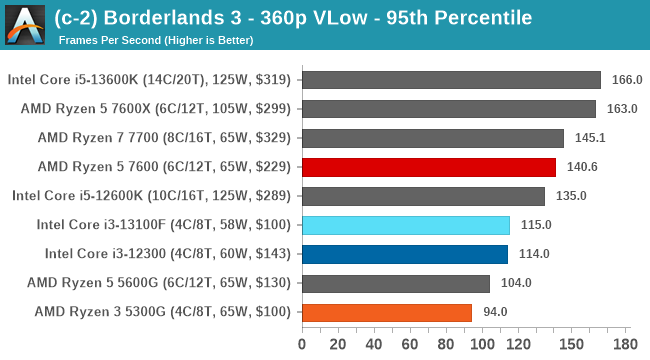
Grand Theft Auto V
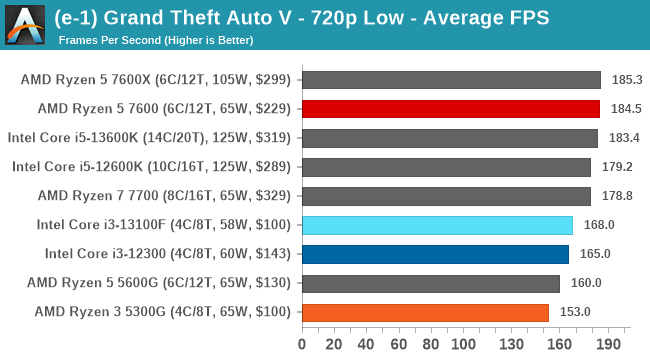
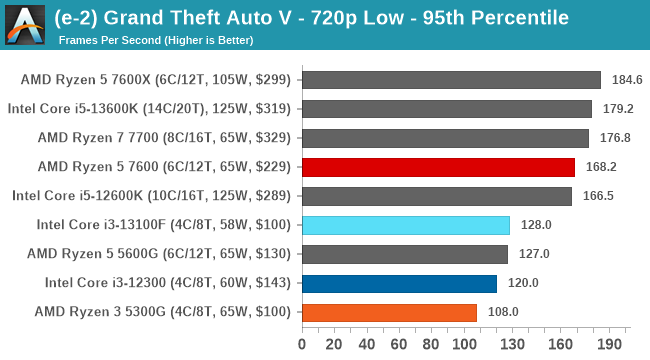
Red Dead Redemption 2

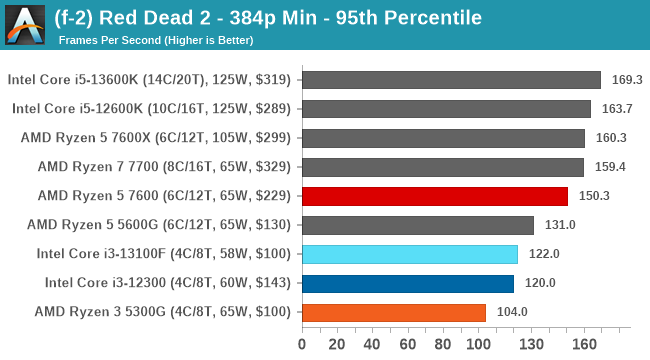
F1 2022
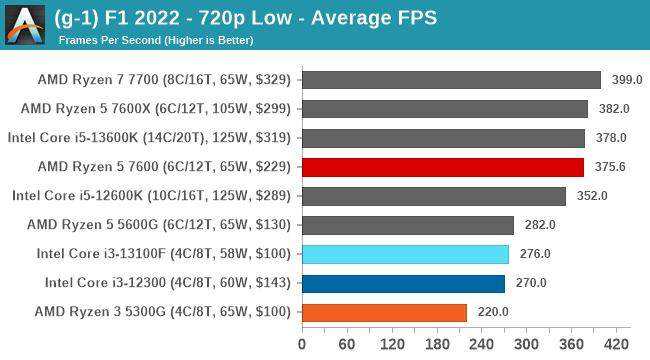

Hitman 3
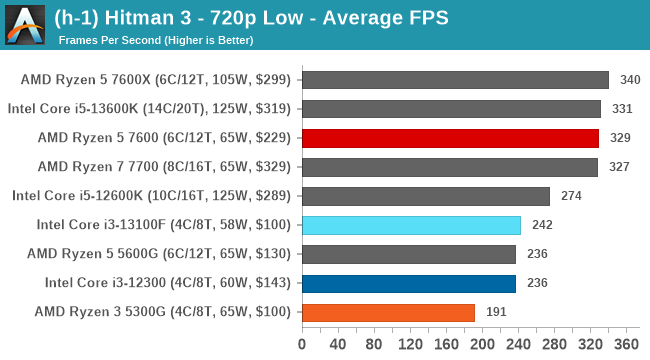

Total War: Warhammer 3

While the compute performance is good for a quad-core but not quite up with the competition, it's time to move on to gaming performance. Starting with testing at 720p, which is a very CPU dependant resolution, we see the Core i3-13100F show its limitations as a quad-core processor once again.
While the charts paint a picture of clear domination for the other processors against the quad-core Intel pairing, it's worth noting that performance in EVERY one of our 720p results denotes both quad-core chips as having playable framerates, in fact, unquestionably playable frame rates at lower resolutions when paired with a good discrete graphics card.
Gaming Performance: 1080p
Moving along, here's a look at a more balanced gaming scenario, running games at 1080p with maximum image quality.
We are using DDR5-4800 memory on the Intel Core i3-13100F as per the JEDEC specifications. Other recent chips, such as Intel's 13th/12th Gen Core series and Ryzen 7000 processors, are also tested at the rated JEDEC specifications. We tested the aforementioned platforms with the following settings:
- DDR5-5600B CL46 - Intel 13th Gen
- DDR5-5200 CL44 - Ryzen 7000
- DDR5-4800 (B) CL40 - Intel 12th Gen
- DDR5-4800 (B) CL40 - Intel 13th Gen Core i3 series
All other CPUs such as Ryzen 5000 and 3000 were tested at the relevant JEDEC settings as per the processor's individual memory support with DDR4.
Civilization VI
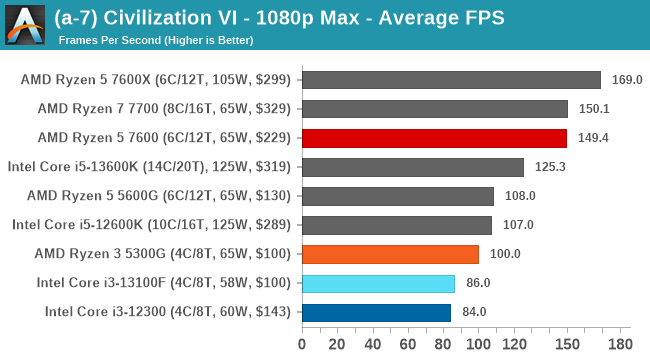
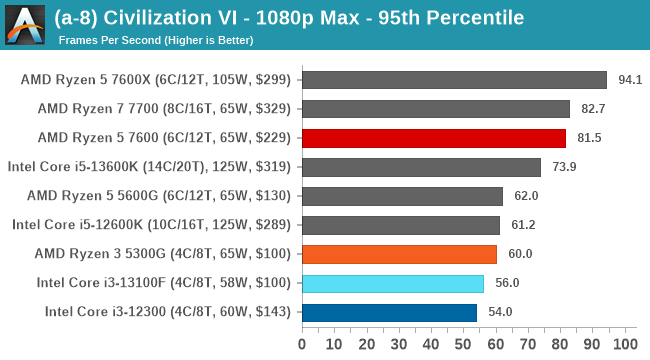
World of Tanks
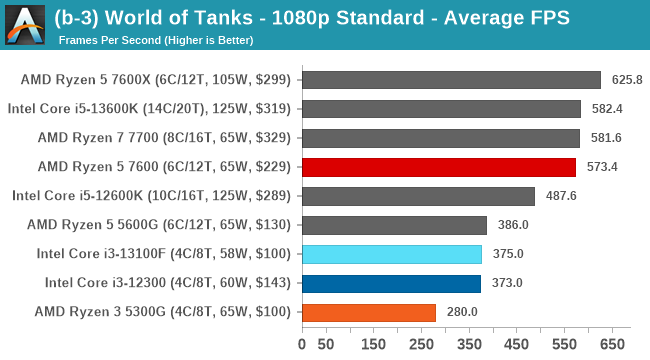
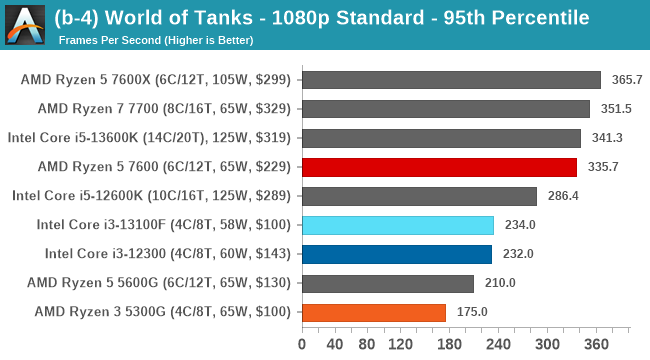
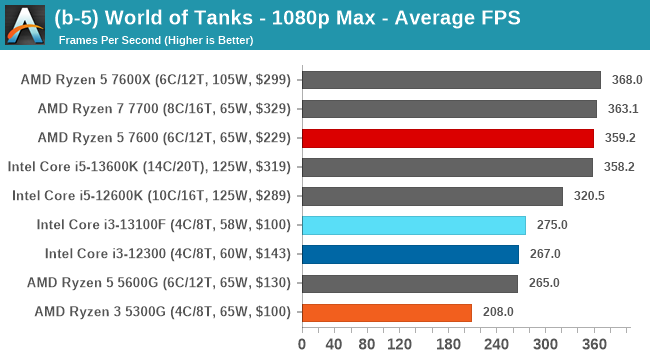
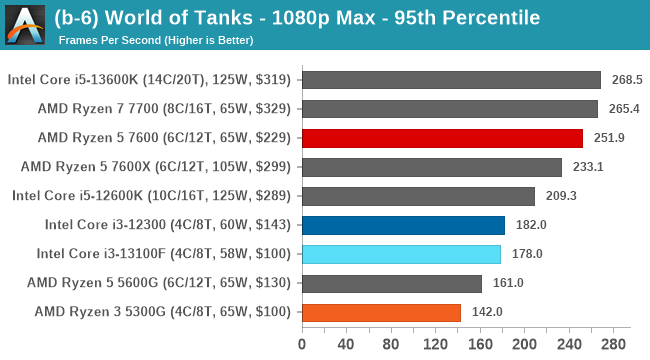
Borderlands 3
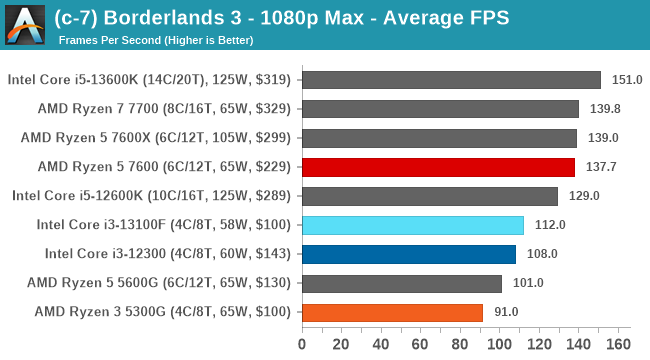
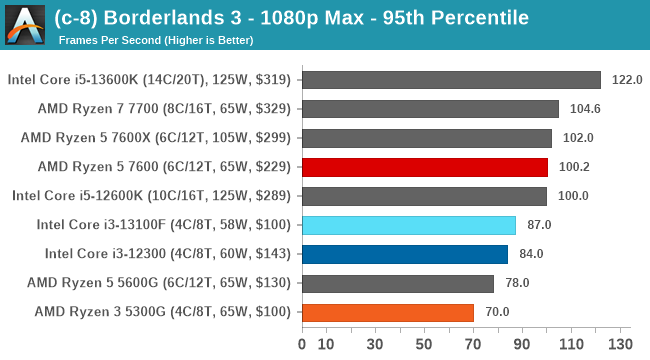
Grand Theft Auto V


Red Dead Redemption 2

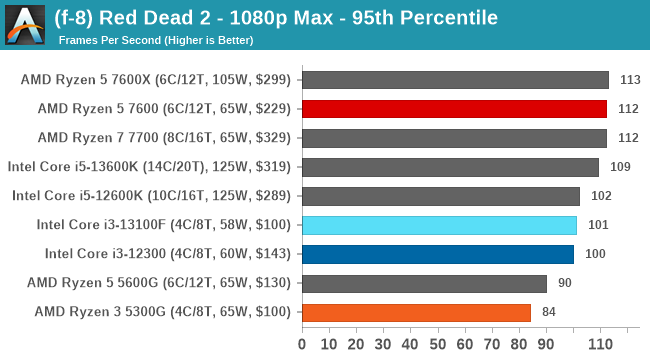
F1 2022
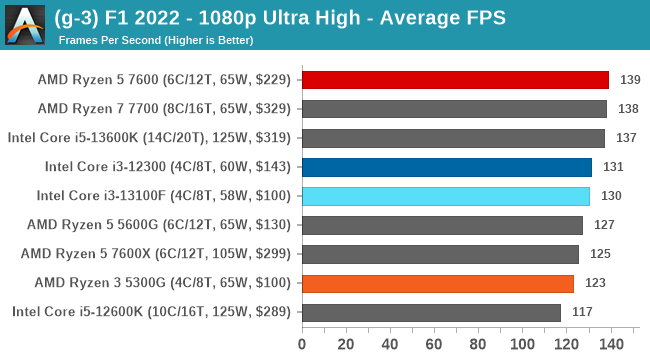
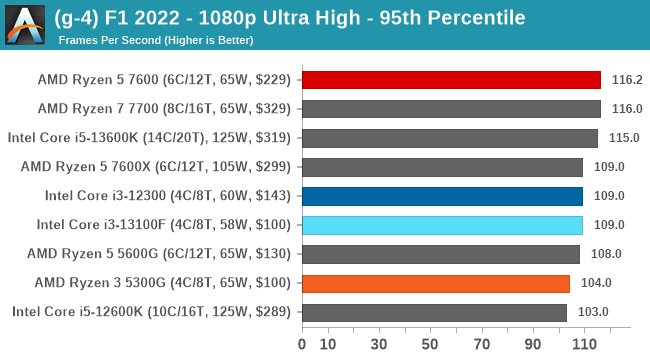
Hitman 3
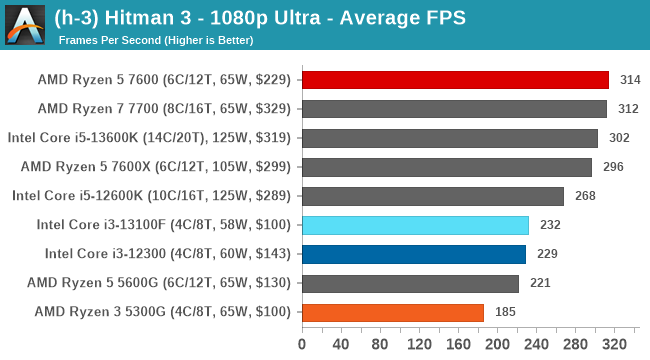
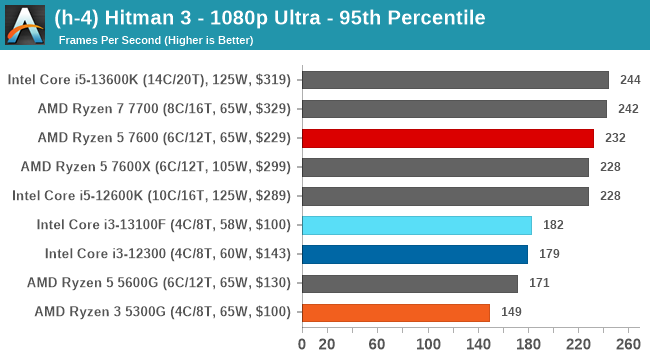
Total War: Warhammer 3
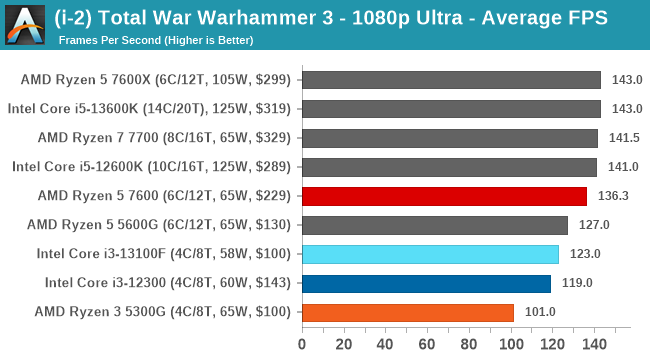
Moving on up to the 1080p resolution, we see the Core i3-13100F in a better light with adequately playable frame rates and competent 5% low performance. We are still seeing limitations to opting for four cores, especially against AMD's Ryzen 5 7600 ($229), albeit it is at double the MSRP price.
Conclusion
It feels like it's been ages since a quad-core CPU was considered an essential SKU in Intel's arsenal. Throughout many generations of Intel's architectures, including the fabled Sandy Bridge, Haswell, and Skylake, to name a few, it wasn't until the launch of its Coffee Lake family of parts (8th Gen Core) that we saw Intel going beyond four cores for its desktop platform. Since then, Intel hasn't looked back. They have iteratively increased their core/thread counts with the optimization and efficiency of their manufacturing processes, leading to processors with core counts that would have seemed absurd at the start of the Sandy Bridge era.
But, in 2023, is there value to be had in a desktop CPU that offers just four CPU cores? Right now, a four core CPU is certainly at the extreme end of matters for an Intel desktop platform, with the same 13th Gen Core series offering up to 24 cores on its top SKUs. The same can be said for AMD's top-tier offerings, such as the Ryzen 9 7950X, the gaming-centric Ryzen 9 7950X3D, and Ryzen 9 7900X3D, as well as the most recent Ryzen 7 7800X3D. The issue, of course, is that not everyone can afford such an expensive CPU as the ones mentioned above, which typically cost upwards of $600. That's where options such as the quad-core Intel Core i3-13100F come into play with a far friendlier price tag of $100.
Even in the sub $150 space, AMD has the previous generation Ryzen 5 5600G 6-core APU, which is currently $138 at Amazon, and the entry-level quad-core Ryzen 3 5300G. Although the Ryzen 3 5300G was OEM only at its launch, these days it's publicly available for around $100, making it AMD's most recent quad-core offering on the market. With the Core i3-13100F also running for $100 at Amazon currently, the budget space certainly has plenty of options to select from, but it's time to see how the latest quad-core from Intel stacks up against the rest.
Intel Core i3-13100F Performance Analysis
Let's make no mistake about it; the Core i3 series isn't designed for heavy and intensive workloads, multi-threaded performance, or tasks such as video rendering and encoding, but for an MSRP of $109 and a current selling price of $100 at Amazon, quad-core desktop systems aren't dead, at least not yet. As we've done recently in our CPU reviews, we're splitting our analysis into two sections, compute performance and gaming performance.
Intel Core i3-13100F: Compute Performance, Four Cores has Limitations
Looking at how Intel's latest quad-core offerings compete in the sub $350 processor market, as expected, compute performance is limited considerably in workloads that are optimized for higher core counts. Judging the Core i3-13100F on its merits without comparing performance to the more extensive and much more expensive AMD Ryzen 9 7950X 16C/32T and Intel Core i9-13900K 24C/32T flagships, the Core i3-13100F does very well all things considered.

In our Persistence of Vision Raytracer (POV-Ray) benchmark, we can see that in an optimized multi-threaded workload, the four cores of the Core i3-13100F make it faster than every other quad core chip in our charts – handily surpassing AMD's quad 5300G by around 28% at the same price – but still noticeably behind more expensive chips with more cores. MT-loving workloads are, essentially, what these cheap chips are giving up on in order to keep their costs down and fill out their respective CPU product stacks.

Using the CineBench R23 Single-Threaded test to show the single-threaded performance of the chips tested in this review, we can see that the Core i3-13100F offers an improved result of around 7% compared to the Core i3-12300 for a small 2% bump in turbo core frequency (4400 versus 4500 MHz). That's a respectable gain in single-threaded performance, and multi-threaded performance has been improved by around 4-8% throughout most of our compute testing compared to the Core i3-12300. Comparing it to the Ryzen 3 5300G, the Core i3-13100F is ahead by around 21% in CB23 ST. Meanwhile, in a sign that things aren't quite as stratified overall for the CPU market when it comes to single/lightly-threaded workloads, the i3-13100F is only 5% behind the $229 Ryzen 5 7600, AMD's most budget-friendly Zen 4 architecture chip.
It's a similar story across the majority of our compute-focused test suite, with the Core i3-13100F typically edging the previous generation Core i3-12300 out marginally and coming in with lower levels of performance against AMD's cheapest Ryzen 7000 series processor, the Ryzen 7 7600 which does have six Zen 4 cores under its hood. In multi-threaded tasks, the $138 Ryzen 5 5600G (6C/12T) APU performs remarkably well for its price tag, despite being from the previous generation Zen 3 line-up. As an added bonus, this chip is an APU, it has superior integrated graphics, which for titles outside of recent AAA, is still solid for 60 FPS gaming at low resolutions with lower levels of settings.
Intel Core i3-13100F Gaming Performance: Decent Performance, but Again, has Limitations
Moving onto gaming performance, we can see that gaming with the Core i3-13100F at 720p and 1080p has certain limitations by having just four cores. Despite having superior IPC performance compared to Intel's previous generations, many games now are multi-platform console ports, which is to say that they've been designed around a larger number of CPU cores (and may be questionably optimized for the PC at all).

Despite having a measly four Golden Cove performance (P) cores under the hood, the Core i3-13100F still performs considerably well when paired with an AMD Radeon RX 6950 XT graphics card. Results may vary when paired with lower-end discrete graphics, though as these are all CPU-limited scenarios, most of these trends will hold Still, comparing things on a level basis, e.g., with memory at the highest-rated JEDEC specifications (DDR5-4800 over DDR4-3200) and the same hardware, the Core i3-13100F shows itself as more than good enough to spit out an acceptable number of frames in the games we've included in our benchmark suite.

We saw highly competitive performance between the Core i3-13100F and Core i3-12300, which is to be expected given they are essentially the same processor; one is just badged as 13th Gen and has 100 MHz more on the turbo core clock speeds.
Ultimately, we're not expecting that users going for a gaming system based around a i3-13100 or i3-13100F are aiming for a high-end experience. But quad core chips can't be written off wholesale for budget gaming systems – at least not yet. As multi-platform games shift from the previous gen consoles being the baseline to the current generation, Zen-2 based fare, that will understandably change. But right now there's still a lot a quad core CPU can handle, especially if you're being equally thrifty on the software side of matters and working through your Steam backlog (ed: guilty).
Intel is offering its chips on a cheaper core-to-price ratio, and delivering respectable performance levels at entry-level and mid-range price points. Diving a little deeper into the pricing, the Core i3-13100F costs roughly $25 per core, which drops to $22 per core on the Core i5-13600K. Which makes the latter technically a bit cheaper per core, but it should also be noted that only six of these are P cores, while the remaining eight are lower-performing E cores.
Meanwhile, the Ryzen 5 5600G ($138) costs $23 per core, and the Ryzen 3 5300G ($100) costs $25 per core. Although this isn't a metric that should be entirely relied upon just for performance purposes, it's certainly interesting.
Final Thoughts: Core i3-13100F is Solid at $100 – Just Bring Your Own Video Card
In 2023, technology will continue to evolve, and the demand for processing power will increase. Many entry-level laptops and desktops still have quad-core processors and are perfectly adequate for everyday use. This doesn't always hold for more CPU-intensive tasks, of course, but that's the nature of making a trade-off with a cheaper CPU.
As things stand, while more advanced software such as video editing or 3D rendering may require more processing power, four cores can still perform reasonably for many users. This is especially true if the software is not heavily multi-threaded, meaning it cannot take full advantage of multiple cores simultaneously. In such cases, a quad-core processor such as the Core i3-13100F may provide comparable performance to a higher-core-count processor that is not fully utilized. This is more prevalent in single-threaded applications, but Intel has opted for its Golden Cove performance cores instead of its newer Raptor Cove cores as its go-to cores. This makes the 13th Gen Core i3 series more of a refresh with a clock speed bump than a new product.
Still, it is worth noting that technological advancements have allowed processors to become more efficient and effective in utilizing their available cores. This means that even with just four cores, modern processors can still handle more demanding tasks than before through gains to IPC performance and increases in core clock speeds while remaining at a similar power curve to the previous generation.
If Intel had used its newer Raptor Cove performance (P) cores as it does with its other 13th Gen Core i7 and i9 series, Intel could probably have squeezed out some more performance. Still, it's understandable as it would have inflated the Core i3 pricing up, and with only four cores, it would still be limited in multi-threaded scenarios.
Which brings us to Intel's Core i3-13100F. Intel's cheapest quad core processor in the 13th Gen Core processor stack is an improvement over the 12th Gen Core i3 offerings, though it's rather marginal. The biggest improvement, really, isn't on performance, but rather on price (and thus cost effectiveness). Especially with current retail pricing of just $100, the i3-13100F is a much better deal than the 12th Gen i3 chips it replaces. It's clear that Intel has been meticulous about fine-tuning their product stack, and while the i3-13100F doesn't bring anything new to the table in terms of technology or performance, it does a good job of filling the need for a cheap quad core chip within Intel's lineup.
Not that Intel is being solely insular, here. In the budget market AMD's previous Ryzen 5 5600G ($138) and Ryzen 3 5300G ($100) chips put up a fight, which does shake things up from a performance and pricing perspective. From a pure CPU performance perspective Intel has the better quad core chip, but AMD does have an edge in offering integrated graphics at the same price. It's not an unfamiliar trade-off in this space; system builders who need integrated graphics as well can either turn to AMD's chip or step up to Intel's full i3-13100 ($110), otherwise if you're going the BYOG route, the i3-13100F is in a better position to let everything ride on CPU performance.
For what it's worth, Intel does end up with a slight edge on some platform aspect as well – support for both DDR5 and DDR4 memory come to mind – though even with the recent drops in DDR5 memory prices, it's hard to make an argument for the more expensive memory with such a cheap chip. Still, the use of the common LGA 1700 platform means that i3-13100F systems also leave the door open to upgrading to a more powerful current-generation Raptor Lake processor later on, as rare as that will be.
In summary, while the demand for processing power increases in 2023, the Core i3-13100F can still be a viable and practical option for many users, especially at the entry-level, where basic photo manipulation, word processing, and web browsing are all going on – so long as you bring your own video card.
As stated throughout the review, the Intel Core i3-13100F is currently available for $100 at Amazon. In our opinion, it represents good value for money for entry-level users or when building a system where heavy workloads aren't a key factor. When combined with a motherboard such as the ASRock B660M-HDV ($95) and a 16 GB kit of TeamGroup T-Force Vulcan Z DDR4-3200 memory ($40) for a total of $255, users can use the rest of whatever budget is left on a graphics card which will predominantly set what the system is capable of in gaming.


